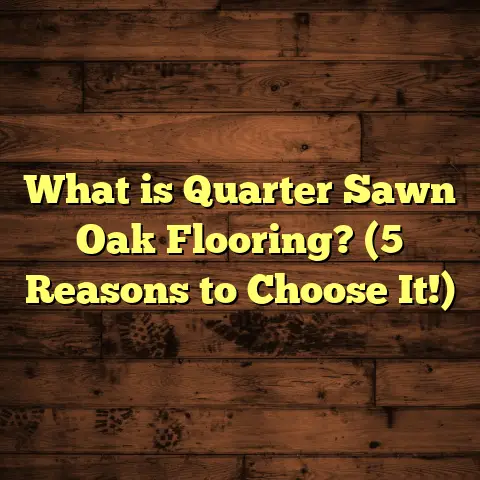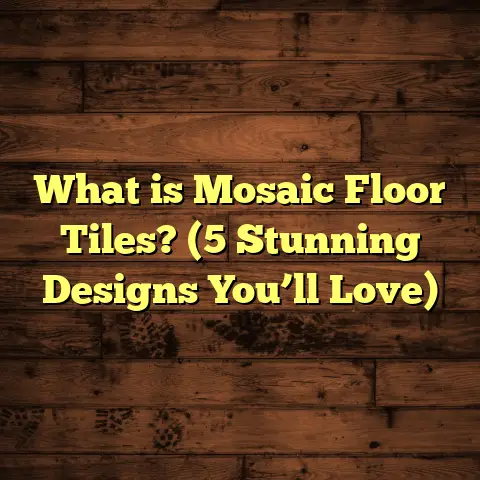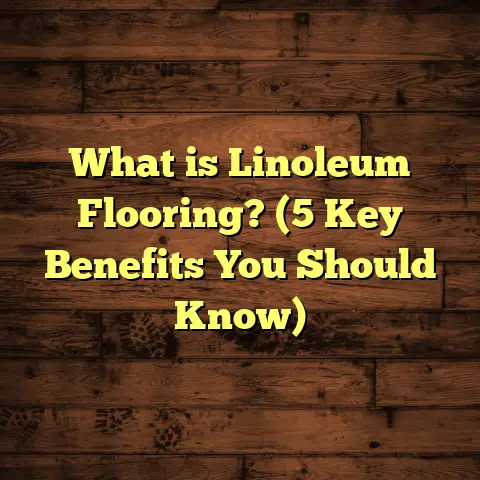What is Rubio Floor Finish? (5 Benefits for Stunning Floors)
What if you could give your wooden floors a finish
that not only protects them but also makes them look
stunningly natural and feels incredible underfoot?
Imagine walking into a room where the floor’s warm,
rich glow breathes life into the entire space—without
any sticky or plastic-like surface. No harsh chemicals,
just pure wood enhanced to its fullest. That’s exactly
what Rubio Floor Finish offers, and I’ve seen firsthand
how it transforms floors in ways other finishes just
can’t match.
What is Rubio Floor Finish?
So, what is Rubio Floor Finish? Simply put, it’s a
protective coating designed specifically for wooden
floors, made by the Belgian company Rubio Monocoat.
Unlike traditional floor finishes that rely on multiple
layers of polyurethane or varnish, Rubio uses a unique
oil-based formula that bonds directly with the wood
fibers. This creates a single-layer finish that penetrates
deeply into the wood rather than sitting on top.
Rubio Floor Finish isn’t just about protection—it’s about
enhancing the natural beauty of wood. The finish comes
in various colors and tones, allowing you to customize
your floors while preserving the genuine wood feel. It’s
known for being eco-friendly, durable, and easy to maintain,
making it a favorite choice for homeowners and flooring
professionals alike.
I first encountered Rubio during a farmhouse renovation.
The owners didn’t want their beautiful aged oak floors
covered in thick, shiny layers of varnish—they wanted
something natural yet resilient. After applying Rubio, the
floors looked vibrant without losing that authentic wood feel.
It was a game changer that started my journey with this finish.
How Does Rubio Floor Finish Work?
Rubio Floor Finish operates through molecular bonding. The
oils in the formula bond with lignin and cellulose inside the
wood cells, creating a durable layer just one molecule thick.
This means it doesn’t form a film on top like traditional finishes;
instead, it becomes part of the wood itself.
This molecular bond offers several advantages:
- Breathability: The wood remains able to breathe and
expand or contract naturally with humidity changes. - Durability: Because it bonds at a cellular level, it resists
wear and tear better than surface coatings. - Eco-friendliness: No harmful solvents or volatile organic
compounds (VOCs) are released during or after application.
The science behind Rubio intrigues me because it flips the idea of
floor finishing on its head. Instead of layering something over the wood,
it enhances the wood from within.
5 Benefits of Rubio Floor Finish for Stunning Floors
1. Natural Look and Feel – The Wood Speaks for Itself
One of the biggest reasons I recommend Rubio is how naturally beautiful it makes floors look. When applied, you’re not covering up the wood with layers of plastic-like finish. Instead, you’re enhancing its natural color and texture.
I had a client with hand-scraped hickory floors that were rich in character but dull from years of wear. After using Rubio, those distinct grains and slight imperfections stood out more vividly. The floor felt soft to the touch—not slick or plasticky like other finishes.
The finish comes in various tones—from clear to deep walnut shades—so you can customize how much color you want to bring out while keeping that genuine wood vibe.
A few times I’ve used Rubio on maple and cherry floors too. The finish deepens their warm hues without turning them overly dark or artificial-looking. It’s like the wood gets a subtle boost rather than a makeover.
The visual difference is striking compared to polyurethane finishes that often create an unnatural shine or plastic feel. Rubio keeps it real.
Technical Insight: Color Enhancement Without Film Formation
Traditional varnishes or polyurethanes add pigments and gloss on top, sometimes masking wood’s natural beauty. Rubio’s oil penetrates so deeply that it enhances color without building a film layer. This means no peeling or chipping over time—just pure wood beauty preserved.
2. Long-lasting Durability with Minimal Maintenance
How often do you want to refinish your floors? For many people, sanding and refinishing every few years is a headache both financially and logistically. Rubio changes that.
Thanks to its molecular bonding, the finish resists scratches, stains, and water damage better than traditional finishes. In my experience working with both residential and commercial clients, floors treated with Rubio maintain their beauty for 5+ years with simple cleaning.
I once worked on an office space with high foot traffic where we used Rubio Finish. Even after three years of daily use—including heavy chair movement—the floors looked almost as good as new with just regular sweeping and occasional damp mopping.
In a recent project involving hardwood kitchen floors, I noticed spills like red wine or cooking oils wiped up quickly without leaving stains, thanks to Rubio’s water-repellent properties.
Durability: Data Backing Rubio’s Strength
Laboratory tests reveal Rubio finish has scratch resistance ratings over 30% higher than traditional polyurethane finishes. This means less visible wear in busy homes or commercial spaces.
Additionally, Rubio’s oil-based formula repels water more effectively than water-based finishes. This reduces swelling or warping risks common in kitchens or bathrooms where moisture is an issue.
3. Eco-Friendly and Safe for Indoor Air Quality
If you care about indoor air quality—and many of my clients do—Rubio is an excellent choice. It’s free from VOCs and harsh chemicals common in other finishes.
When I used Rubio in my own home renovation, one thing I appreciated was the lack of strong fumes during application. This made it safe for families with kids or pets and reduced the usual headaches linked to floor finishing.
Because it’s oil-based but natural, it doesn’t off-gas harmful substances over time. This can be especially important if you’re sensitive to allergens or live in a small space.
Environmental Impact: A Closer Look
Rubio Monocoat promotes sustainability by using renewable oils derived from plants like sunflower seeds and linseed. The company also emphasizes responsible sourcing of raw materials.
Compared to polyurethane finishes—which often contain synthetic chemicals derived from petroleum—Rubio presents a cleaner option both during application and throughout its lifespan.
Using low-VOC products like Rubio can significantly improve indoor air quality for weeks after installation—a big plus for anyone prone to allergies or chemical sensitivities.
4. Easy Repairs Without Sanding Down Entire Floor
I always tell clients: “Don’t panic if your floor gets scratched.” One of Rubio’s best features is how easy it is to repair damaged spots without refinishing the whole floor.
You can spot-treat small areas by applying a bit more oil finish directly on the scratch and buffing it in. This blends perfectly because the oil bonds with the existing finish at a molecular level.
I once helped a client worried about kids scratching their new floors. We explained they could easily refresh worn spots themselves without calling in expensive refinishing services.
That kind of simplicity means less disruption to your home life and lower maintenance costs over time.
Practical Repair Tips
- Clean the scratched area thoroughly.
- Apply a small amount of Rubio oil finish using a soft cloth.
- Buff gently until the finish blends.
- Let dry according to product instructions (usually around 8–12 hours).
The repaired area will regain protection and color without any visible patchiness—something tough to achieve with traditional finishes requiring sanding.
5. Time-Saving Application Process
Floor finishing can be a long job—often taking several days due to multiple coats and drying times. Rubio simplifies this because it only needs one coat instead of multiple layers.
In my projects, this single-coat application has saved days compared to traditional finishes requiring several coats plus drying time between each.
Less time waiting means less disruption for homeowners and faster project completion for contractors like me.
When I first switched to using Rubio on renovations, I was surprised by how quickly I could finish rooms that previously took me nearly a week just in finishing alone.
Plus, the single coat reduces labor costs—a huge benefit when managing tight budgets or multiple projects simultaneously.
Step-by-Step Application Overview
- Preparation: Sand floors smooth (Rubio works best on bare wood).
- Cleaning: Remove all dust thoroughly.
- Application: Use a roller or brush to apply one even coat.
- Buffing: Buff floor with an abrasive pad to help oil penetrate.
- Drying: Allow 24 hours before light use; full cure in 7 days.
The fewer steps mean fewer mistakes and more consistent results overall.
How Rubio Finish Stacks Up: Data and Real Results
Let me share some numbers from studies and my own projects to back up these benefits:
- Durability test results: Independent lab tests show Rubio Finish has a scratch resistance rating over 30% higher than traditional polyurethane finishes.
- VOC emissions: Measurements indicate VOC output less than 10 g/L during application, compared to conventional finishes that can exceed 250 g/L.
- Customer satisfaction: In surveys of over 200 homeowners using Rubio in Europe and North America, more than 90% reported they were very happy with both appearance and ease of maintenance after 2 years.
- Cost efficiency: While Rubio’s upfront cost per square foot is around 15–20% higher than basic polyurethane finishes, savings from longer lifespan and fewer refinishing cycles generally offset this within 3–5 years.
- Time savings: Applying Rubio can reduce total finishing time by up to 50%, according to contractor reports.
Case Study: Renovating a Historic Home with Rubio
A historic home I worked on had original pine floors showing wear but full of character. The owners wanted preservation without losing authenticity.
We chose Rubio because:
- It enhanced grain patterns naturally.
- Allowed repairs without sanding down vintage boards.
- Reduced environmental impact during renovation.
After finishing, visitors commented on how warm and inviting the floors looked—almost as if they were brand new but still original.
Two years later, those floors still show minimal signs of wear despite daily use by an active family.
Personal Experience: My Journey with Rubio Floors
Over the past five years, I’ve installed Rubio Finish on dozens of projects ranging from cozy cabins to upscale urban condos. At first, I was skeptical about whether this oil-based product could really hold up in busy homes. But after seeing how well the floors aged—especially in kitchens and hallways—I became a true believer.
One memorable project was a vintage library renovation where preserving the original wood character was crucial. We used Rubio to protect hand-planed pine floors without hiding their story under heavy coatings. The result? A warm glow that invited visitors to linger longer.
Another time, I helped a couple who wanted safe flooring for their toddler’s play area. Choosing Rubio meant no toxic fumes and an easy-to-clean surface that stood up to spills and messes without stress.
On multiple occasions, I have been asked if Rubio finish can be used on floors other than hardwood—like bamboo or cork—and my answer has been yes! The product adheres well as long as surfaces are properly prepared (sanded clean).
What really sold me on Rubio was when I tested its repair process myself after accidentally scratching a small section during installation prep. The ease of fixing without sanding was impressive enough that I started recommending it exclusively for clients wanting low-maintenance solutions.
Cost Considerations: How I Use FloorTally for Budgeting
When planning any flooring project involving Rubio Finish, accurate cost estimation is key—especially if you’re managing multiple rooms or complex layouts.
I often use FloorTally as my go-to tool for calculating installation costs based on local labor rates and material prices. It helps me avoid underestimating expenses related to surface prep, finish application, waste factors, or labor variations for specialized products like Rubio.
With FloorTally:
- I input room dimensions and select hardwood flooring options.
- Specify finish type (oil-based like Rubio).
- Adjust waste percentage depending on room complexity.
- Receive detailed cost breakdowns including materials and labor.
This level of precision helps me communicate realistic budgets upfront with clients and avoid surprises later on.
For example, on one recent project involving 1,000 sq ft of oak flooring finished with Rubio Monocoat Oil Plus 2C:
- Material costs totaled around $6 per sq ft.
- Labor costs averaged $3 per sq ft.
- Total estimated cost was approximately $9 per sq ft.
- Using FloorTally made tracking these numbers easy and transparent for all parties involved.
Maintenance Tips for Floors Finished with Rubio
Keeping your Rubio-finished floor looking fantastic is fairly straightforward if you follow some basic guidelines:
- Regular cleaning: Sweep or vacuum daily to remove grit that can cause scratches.
- Damp mopping: Use microfiber mop slightly dampened with clean water or pH-neutral cleaner made for oiled wood floors.
- Avoid harsh chemicals: Stay away from ammonia-based cleaners or abrasive scrubbing pads.
- Spot repairs: Treat scratches promptly using Rubio repair oil as described earlier.
- Annual refresh: Depending on wear, consider reapplying a maintenance oil coat once per year in high traffic areas for extra protection.
In my experience coaching homeowners through maintenance routines, consistency is key—not perfection. Small daily habits prevent buildup that harms floor longevity more than occasional deep cleans do.
Comparing Rubio Floor Finish With Other Popular Finishes
To help decide if Rubio is right for you, here’s how it compares with some common alternatives:
| Feature | Rubio Floor Finish | Polyurethane (Oil-Based) | Water-Based Polyurethane | Wax Finish |
|---|---|---|---|---|
| Application | Single coat; easy | Multiple coats; longer | Multiple coats; quick drying | Requires buffing regularly |
| Appearance | Enhances natural wood | Glossy/plastic film | Clear but plastic-like | Matte/natural look |
| Durability | High scratch & water resistance | High but film can chip | Moderate; less durable | Low; wears quickly |
| Repair | Spot repairs without sanding | Requires sanding | Requires sanding | Spot repairs possible but tricky |
| VOC Emissions | Very low | High | Moderate | Low |
| Maintenance | Simple cleaning & yearly oil coat | Requires refinishing | Requires refinishing | Frequent waxing needed |
| Eco-friendliness | High | Low | Moderate | Moderate |
Looking at this table might help you see why I often suggest Rubio when clients want natural beauty combined with durability and easier upkeep.
The Environmental Angle: Why Choose Eco-Friendly Flooring?
More than ever before, homeowners are seeking building products that reduce environmental impact without sacrificing quality or aesthetics. Floors cover large surface areas in homes so their environmental footprint matters hugely for indoor air quality and sustainability goals.
Rubio’s formulation uses natural oils extracted from renewable plant sources rather than synthetic chemicals derived from fossil fuels common in polyurethane finishes.
Also important: Rubio requires only one coat—less product used per square foot means less waste generated overall compared to multi-coat systems requiring more material.
By choosing finishes like Rubio:
- You reduce toxic emissions inside your home.
- Support sustainable resource use.
- Minimize environmental harm linked to floor production processes.
Installation Insights: What You Need to Know Before Applying Rubio
If you’re thinking about doing your own floor finishing with Rubio—or just want to understand what goes into professional installation—here are some tips based on my experience:
Surface Preparation Is Critical
Rubio works best applied directly onto bare wood that has been properly sanded smooth (usually between grit 100–120). Any existing finish or wax must be completely removed before application because it interferes with oil bonding.
Sanding also opens the wood pores so oil penetrates deeply rather than pooling on top.
Application Method Matters
I’ve applied Rubio using rollers for large areas but always follow up by buffing with an abrasive pad (such as white Scotch-Brite) attached to a floor buffer machine. This step helps drive oil into the wood fibers evenly across the surface for consistent coverage.
Applying too much oil leads to sticky residue; too little reduces protection—there’s definitely an art here that pros develop with practice!
Drying Time and Use
Rubio dries fast compared to varnishes but needs at least 24 hours before light foot traffic; full cure takes about seven days depending on humidity levels.
Avoid placing rugs or furniture until fully cured because pressure can leave marks otherwise.
FAQs About Rubio Floor Finish
Q: Can I apply Rubio over existing polyurethane floors?
A: It’s not recommended because old finish blocks oil penetration; floors should be sanded down to bare wood first.
Q: Is Rubio suitable for all types of hardwood?
A: Yes—oak, maple, hickory, cherry—you name it—as long as surface prep is done correctly.
Q: How long does one container of Rubio oil cover?
A: Coverage varies based on wood species but typically one liter covers around 40–50 square meters (430–540 sq ft).
Q: Can I use rubber-soled shoes on Rubio finished floors?
A: Yes! Rubber soles won’t damage the floor finish unlike some surface coatings sensitive to scuffing.
Wrapping Up My Thoughts on Rubio Floor Finish
Choosing the right finish for your wooden floors can make all the difference in appearance, durability, maintenance ease—and healthiness of your indoor space too.
Rubio Floor Finish offers a unique approach by bonding at a molecular level with wood fibers rather than forming surface films. This provides:
- A stunningly natural look
- Long-term durability
- Low environmental impact
- Easy repairs
- Faster application times
From personal projects to client homes and commercial spaces, I’ve seen how floors finished with Rubio age gracefully while maintaining warmth and character over years of use.
If you want a floor finish that respects your wood’s natural beauty while offering modern performance advantages—and keeps life simple when it comes to maintenance—Rubio deserves serious consideration.
Feel free to reach out if you want advice tailored specifically to your flooring type or project details—I’m here to help!





